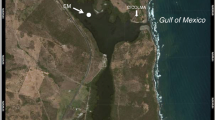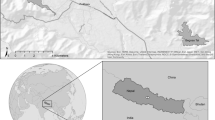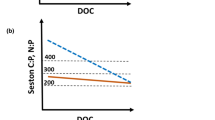Abstract
Phytoplankton uptake rates of ammonium (NH4 +), nitrate (NO3 −), and urea were measured at various depths (light levels) in Hong Kong waters during the summer of 2008 using 15N tracer techniques in order to determine which form of nitrogen (N) supported algal growth. Four regions were sampled, two differentially impacted by Pearl River discharge, one impacted by Hong Kong sewage discharge, and a site beyond these influences. Spatial differences in nutrient concentrations, ratios, and phytoplankton biomass were large. Dissolved nutrient ratios suggested phosphorus (P) limitation throughout the region, largely driven by high N loading from the Pearl River in summer. NH4 + and urea made up generally ≥50% of the total N taken up and the f ratio averaged 0.26. Even at the river-impacted site where concentrations of NO3 − were >20 μM N, NH4 + comprised >60% of the total N uptake. Inhibition experiments demonstrated that NO3 − uptake rates were reduced by 40% when NH4 + was >5 μM N. The relationship between the total specific uptake rates of N (sum of all measured substrates, V, per hour) and the chlorophyll a-specific rates (micromolars of N per microgram of Chl a per hour) varied spatially with phytoplankton biomass. Highest uptake rates and biomass were observed in southern waters, suggesting that P limitation and other factors (i.e., flushing rate) controlled production inshore and that the unincorporated N (mainly NO3 −) was transported offshore. These results suggest that, at the beginning of summer, inshore algal blooms are fueled primarily by NH4 + and urea, rather than NO3 −, from the Pearl River discharge. When NH4 + and urea are depleted, then NO3 − is taken up and can increase the magnitude of the bloom.














Similar content being viewed by others
References
Bates, S.S. 1976. Effects of light and ammonium on nitrate uptake by two species of estuarine phytoplankton. Limnology and Oceanography 21: 212–218.
Berges, J.A., W.P. Cochlan, and P.J. Harrison. 1995. Laboratory and field responses of algal nitrate reductase to diel periodicity in irradiance, nitrate exhaustion, and the presence of ammonium. Marine Ecology Progress Series 124: 259–269.
Bode, A., N. González, C. Rodríguez, M. Varela, and M.M. Varela. 2005. Seasonal variability of plankton blooms in the Rio de Ferrol (NW Spain): I. Nutrient concentrations and nitrogen uptake rates. Estuarine Coastal and Shelf Science 63: 269–284.
Boyer, E.W., R.W. Howarth, J.N. Galloway, F.J. Dentener, P.A. Green, and C.J. Vorosmarty. 2006. Riverine nitrogen export from the continents to the coasts. Global Biogeochem Cycles 20: GB1S91. doi:10.1029/2005GB002537.
Broom, M., G. Chiu, and A. Lee. 2003. Long-term water quality trends in Hong Kong. In Perspectives on marine environment change in Hong Kong and Southern China, 1977–2001, ed. B. Morton, 534. Hong Kong: Hong Kong University Press.
Chang, J., F.K. Shiah, G.C. Gong, and K.P. Chiang. 2003. Cross-shelf variation in carbon-to-chlorophyll a ratios in the East China Sea, summer 1998. Deep-Sea Research Part II 50: 1237–1247.
Chen, B., H. Liu, M.B. Landry, M. Chen, J. Sun, L. Shek, X. Chen, and P.J. Harrison. 2009. Estuarine nutrient loading affects phytoplankton growth and microzooplankton grazing at two contrasting sites in Hong Kong coastal waters. Marine Ecology Progress Series 379: 77–90.
Choi, K.W., J.H.W. Lee, K.W.H. Kwok, and K.M.Y. Leung. 2009. Integrated stochastic environmental risk assessment of the harbor area treatment scheme (HATS) in Hong Kong. Environmental Science and Technology 43: 3705–3711.
Cloern, J.E. 2001. Our evolving conceptual model of the coastal eutrophication problem. Marine Ecology Progress Series 210: 223–253.
Dickson, M.L., and P.A. Wheeler. 1995. Nitrate uptake rates in a coastal upwelling regimes: A comparison of PN-specific, absolute, and Chl a-specific rates. Limnology and Oceanography 40: 533–543.
Dortch, Q. 1990. The interaction between ammonium and nitrate uptake in phytoplankton. Marine Ecology Progress Series 61: 183–201.
Dortch, Q., and H.L. Conway. 1984. Interactions between nitrate and ammonium uptake: Variation with growth rate, nitrogen source and species. Marine Bioloby 79: 151–164.
Dortch, Q., P.A. Thompson, and P.J. Harrison. 1991. Short-term interaction between nitrate and ammonium uptake in Thalassiosira pseudonana: Effect of preconditioning nitrogen source and growth rate. Marine Biology 110: 183–193.
Dugdale, R.C., F.P. Wilkerson, V.E. Hogue, and A. Marchi. 2007. The role of ammonium and nitrate in spring bloom development in San Francisco Bay. Estuarine, Coastal and Shelf Science 73: 17–29.
Eppley, R.W., and B.J. Peterson. 1979. Particulate organic matter flux and planktonic new production in the deep ocean. Nature 282: 677–680.
Galloway, J.N., and E.B. Cowling. 2002. Nitrogen and the world: 200 years of change. Ambio 31: 64–71.
Galloway, J.N., E.B. Cowling, S.P. Seitzinger, and R.H. Socolow. 2002. Reactive nitrogen: Too much of a good thing. Ambio 31: 60–63.
Glibert, P.M. 1982. Regional studies of daily, seasonal and size fraction in ammonium remineralization. Marine Biology 70: 209–222.
Glibert, P.M., and D.G. Capone. 1993. Mineralization and assimilation in aquatic, sediment, and wetland systems. In Nitrogen isotope techniques, ed. R. Knowles and T.H. Blackburn, 243–271. San Diego: Academic.
Glibert, P.M., J. Harrison, C. Heil, and S. Seitzinger. 2006. Escalating worldwide use of urea—A global change contributing to coastal eutrophication. Biogeochemistry 77: 441–463.
Glibert, P.M., R. Azanza, M. Burford, K. Furuya, et al. 2008. Ocean urea fertilization for carbon credits poses high ecological risks. Marine Pollution Bulletin 56: 1049–1056.
Glibert, P.M., J.I. Allen, L. Bouwman, C. Brown, K.J. Flynn, A. Lewitus, and C. Madden. 2010. Modeling of HABs and eutrophication: Status, advances, challenges. Journal of Marine Systems 83: 262–275.
Grasshoff, K.M., K. Kremling, and M. Ehrhardt. 1999. Methods of seawater analysis. New York: Wiley-VCH.
Harrison, W.G., T. Platt, and R. Lewis. 1987. f-ratio and its relationship to ambient nitrate concentration in coastal waters. Journal of Plankton Research 9: 249–253.
Harrison, J.H., N.F. Caraco, and S.P. Seitzinger. 2005a. Global patterns and sources of dissolved organic matter export to the coastal zone: Results from a spatially explicit, global model. Global Biogeochem Cycles 19: GBS406.
Harrison, J.H., S.P. Seitzinger, N. Caraco, A.F. Bouwman, A. Beusen, and C. Vörösmarty. 2005b. Dissolved inorganic phosphorous export to the coastal zone: Results from a new, spatially explicit, global model (NEWS-SRP). Global Biogeochemical Cycles 19(4): GB4S03.
Harrison, P.J., K.D. Yin, J.H.W. Lee, J.P. Gan, and H.B. Liu. 2008. Physical–biological coupling in the Pearl River Estuary. Continental Shelf Research 28: 1405–1415.
Heisler, J., P. Glibert, J. Burkholder, D. Anderson, W. Cochlan, W. Dennison, Q. Dortch, C. Gobler, C. Heil, E. Humphries, A. Lewitus, R. Magnien, H. Marshall, K. Sellner, D. Stockwell, D. Stoecker, and M. Suddleson. 2008. Eutrophication and harmful algal blooms: A scientific consensus. Harmful Algae 8: 3–13.
Herndon, J., and W.P. Cochlan. 2007. Nitrogen utilization by the raphidophyte Heterosigma akashiwo: Growth and uptake kinetics in laboratory cultures. Harmful Algae 6: 260–270.
Ho, A.Y.T., J. Xu, K. Yin, Y. Jiang, X. Yuan, L. He, D.M. Anderson, J.H.W. Lee, and P.J. Harrison. 2010. Phytoplankton biomass and production in subtropical Hong Kong waters: Influence of Pearl River outflow. Estuaries and Coasts 33: 170–181.
Holligan, P.N., R.P. Harris, R.C. Newell, D.S. Harbour, R.N. Head, E.A.S. Linley, M.I. Lucas, P.R.G. Tranter, and C.M. Weekley. 1984. Vertical distribution and partitioning of organic carbon in mixed, frontal and stratified waters of the English Channel. Marine Ecology Progress Series 14: 111–127.
Howarth, R.W., A. Sharpley, and D. Walker. 2002. Sources of nutrient pollution to coastal water in the United States: Implications for achieving coastal water quality goals. Estuaries 25: 656–676.
Knap, A., A. Michaels, A. Close, H. Ducklow, and A. Dickson. 1996. [eds]. Protocols for the Joint Global Ocean Flux Study (JGOFS) Core Measurements. JGOFS report No 19, vi + 170 pp. Reprint of the IOC Manual and Guides No. 29, UNESCO 1994.
Kokkinakis, S.A., and P.A. Wheeler. 1987. Nitrogen uptake and phytoplankton growth in coastal upwelling regions. Limnology and Oceanography 32: 1112–1123.
L’Helguen, S., C. Madec, and P.L. Corre. 1996. Nitrogen uptake in the permanently well-mixed temperature coastal waters. Estuarine, Coastal and Shelf Science 42: 803–818.
L’Helguen, S., J.F. Maguer, and J. Caradec. 2008. Inhibition kinetics of nitrate uptake by ammonium in size-fractionated oceanic phytoplankton communities: Implications for new production and f-ratio estimates. Journal of Plankton Research 30: 1179–1188.
Lee, J.H.W., P.J. Harrison, C. Kuang, and K.D. Yin. 2006. Eutrophication dynamics in Hong Kong coastal waters: Physical and biological interactions. In The environment in Asia Pacific harbours, ed. E. Wolanski, 187–206. Netherlands: Springer.
Lipschultz, F. 1995. Nitrogen-specific uptake rates of marine phytoplankton isolated from natural populations of particles by flow cytometry. Marine Ecology Progress Series 123: 245–258.
Lomas, M.W., and P.M. Glibert. 1999a. Temperature regulation of nitrate uptake: A novel hypotheses about nitrate uptake and reduction in cool-water diatoms. Limnology and Oceanography 44: 556–572.
Lomas, M.W., and P.M. Glibert. 1999b. Interactions between NH4 + and NO3 − uptake and assimilation: Comparison of diatoms and dinoflagellates at several growth temperatures. Marine Biology 133: 541–551.
Lomas, M.W., and P.M. Glibert. 2000. Comparisons of nitrate uptake, storage and reduction in marine diatoms and flagellates. Journal of Phycology 36: 903–913.
Lund, B.A. 1987. Mutual interference of ammonium, nitrate and urea on uptake of 15N sources by the marine Skeletonema costatum (Grev.) Cleve. Journal of Experimental Marine Biology and Ecology 113: 167–180.
McCarthy, J.J., and J.L. Nevins. 1986. Sources of nitrogen for primary production in warm-core rings 79-D and 81-E. Limnology and Oceanography 31: 690–700.
McCarthy, J.J., W.R. Taylor, and J.L. Taft. 1977. Nitrogenous nutrition of the plankton in the Chesapeake Bay. 1. Nutrient availability and phytoplankton preferences. Limnology and Oceanography 22: 996–1011.
Middelburg, J.J., and J. Nieuwenhuize. 2000. Nitrogen uptake by heterotrophic bacteria and phytoplankton in the nitrate-rich Thames estuary. Marine Ecology Progress Series 203: 13–21.
Parsons, T.R., K. Stephens, and T.T. Strickland. 1961. On the chemical composition of eleven species of marine phytoplankton. Journal of Fishery Research Board of Canada 18: 1001–1116.
Parsons, T.R., Y. Maita, and C.M. Lalli. 1984. A manual for chemical and biological methods for seawater analysis. New York: Pergamon.
Price, N.M., and P.J. Harrison. 1987. A comparison of methods for the measurement of dissolved urea concentration in seawater. Marine Biology 92: 307–319.
Redfield, A.C. 1958. The biological control of chemical factors in the environment. American Science 46: 205–211.
Seitzinger, S.P., C. Kroeze, A.F. Bouwman, N. Caraco, F. Dentener, and R.V. Styles. 2002. Global patterns of dissolved inorganic and particulate nitrogen inputs to coastal systems: Recent conditions and future projections. Estuaries 25: 640–655.
Seitzinger, S.P., J.A. Harrison, E. Dumont, A.H.W. Beusen, and A.F. Bouwman. 2005. Sources and delivery of carbon, nitrogen and phosphorous to the coastal zone: An overview of global nutrient export from watersheds (NEWS) models and their application. Global Biogeochemistry Cycles 19: GB4S09.
Smayda, T.J. 1990. Novel and nuisance phytoplankton blooms in the sea: Evidence for a global epidemic. In Toxic marine phytoplankton, ed. E. Granéli, B. Sundstrom, L. Edler, and D.M. Anderson, 29–40. New York: Elsevier.
Smayda, T.J. 1997. Harmful algal blooms: Their ecophysiology and general relevance to phytoplankton blooms in the sea. Limnology and Oceanography 42: 1137–1153.
Solomon, C.M., J.L. Collier, G.M. Berg, and P.M. Glibert. 2010. Role of urea in microbes in aquatic systems: A biochemical and molecular review. Aquatic Microbial Ecology 59: 67–88.
Suksomjit, M., K. Ichimi, K.I. Hamada, M. Yamada, K. Tada, and P.J. Harrison. 2009. Ammonium accelerates the growth rate of Skeletonema spp. in the phytoplankton assemblage in a heavily eutrophic embayment, Dokai Bay, Japan. La mer 47: 89–101.
Twomey, J.L., M.F. Piehler, and H.W. Paerl. 2005. Phytoplankton uptake of ammonium, nitrate and urea in the Neuse River estuary, NC, USA. Hydrobiologia 533: 123–134.
Van Mooey, B.A.S., H.F. Fredricks, B.E. Pedler, S.T. Dyhrman, D.M. Karl, M. Koblizek, M.W. Lomas, T.J. Mincer, L.R. Moore, T. Moutin, M.S. Rapper, and E.A. Webb. 2009. Phytoplankton in the ocean use non-phosphorus lipids in response to phosphorus scarcity. Nature. doi:10.1038/nature07659.
Wassmann, P. 2004. Cultural eutrophication: Perspectives and prospects. In Drainage basin inputs and eutrophication: An integrated approach, eds. P. Wassmann and K. Olli K, 224–234. Norway: University of Tromso. http://www.ut.ee/~olli/eutr/.
Wienke, S.M., and J.E. Cloern. 1987. The phytoplankton component of seston in San Francisco Bay. Netherland Journal of Sea Research 21: 25–33.
Wood, G.J., and K.J. Flynn. 1995. Growth of Heterosigma carterae (Raphidophceae) on nitrate and ammonium at three photon flux densities: Evidence for N stress in nitrate-growing cells. Journal of Phycology 31: 859–867.
Xu, J. 2007. Nutrient limitation in the Pearl River estuary, Hong Kong waters and adjacent South China Sea waters. Ph.D. Thesis. The Hong Kong University of Science and Technology, Hong Kong, China.
Xu, J., A.Y.T. Ho, K. Yin, X.C. Yuan, D.M. Anderson, J.H.W. Lee, and P.J. Harrison. 2008. Temporal and spatial variations in nutrient stoichiometry and regulation of phytoplankton biomass in Hong Kong waters: Influence of the Pearl River outflow and sewage inputs. Marine Pollution Bulletin 57: 335–348.
Xu, J., K. Yin, A.Y.T. Ho, J.H.W. Lee, D.M. Anderson, and P.J. Harrison. 2009. Nutrient limitation in Hong Kong waters inferred from comparison of nutrient ratio, bioassays and 33P turnover times. Marine Ecology Progress Series 388: 81–97.
Xu, J., K. Yin, H. Liu, J.H.W. Lee, D.M. Anderson, A.Y.T. Ho, and P.J. Harrison. 2010. A comparison of eutrophication impacts in two harbours in Hong Kong with different hydrodynamics. Journal of Marine Systems 83: 276–286.
Yin, K., P.Y. Qian, J.C. Chen, D.P.H. Hsieh, and P.J. Harrison. 2000. Dynamics of nutrients and phytoplankton biomass in the Pearl River estuary and adjacent waters of Hong Kong during summer: Preliminary evidence for phosphorus and silicon limitation. Marine Progress Ecology Series 194: 295–305.
Yin, K., P.Y. Qian, M.C.S. Wu, J.C. Chen, L.M. Huang, X.Y. Song, and W.J. Jian. 2001. Shift from P to N limitation of phytoplankton biomass across the Pearl River estuarine plume during summer. Marine Ecology Progress Series 221: 17–28.
Yuan, X.C., K.D. Yin, P.J. Harrison, W.J. Cai, L. He, and J. Xu. 2010. Bacterial production and respiration in subtropical Hong Kong waters: Influence of the Pearl River discharge and sewage impacts. Aquactic Microbial Ecology 58: 167–179.
Yuan, X.C., P.M. Glibert, J. Xu, H, Liu, M, Chen, H.B. Liu, K. Yin, and P.J. Harrison. 2011. Inorganic and organic nitrogen uptake by phytoplankton and bacteria in Hong Kong waters. Estuaries and Coasts. doi:10.1007/s12237-011-9433-3.
Acknowledgements
This research was supported by the University Grants Council of Hong Kong AoE project (AoE/P-04/04-4-II). This is a contribution of the GEOHAB Core Research Project on HABs in Eutrophic Systems. This is contribution number 4548 from the University of Maryland Center for Environmental Science.
Author information
Authors and Affiliations
Corresponding author
Rights and permissions
About this article
Cite this article
Xu, J., Glibert, P.M., Liu, H. et al. Nitrogen Sources and Rates of Phytoplankton Uptake in Different Regions of Hong Kong Waters in Summer. Estuaries and Coasts 35, 559–571 (2012). https://doi.org/10.1007/s12237-011-9456-9
Received:
Revised:
Accepted:
Published:
Issue Date:
DOI: https://doi.org/10.1007/s12237-011-9456-9




